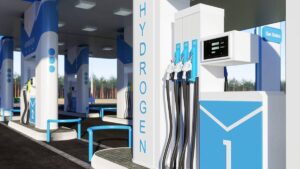Got Gas? Green hydrogen is marching ahead in Australia

Pic: Vertigo3d / E+ via Getty Images
Green hydrogen continues to make waves in Australia with both industry and government announcing investments and acquisitions in recent weeks.
On the public front, the Australian government has awarded more than $100m in conditional funding through the Australian Renewable Energy Agency’s (ARENA) Renewable Hydrogen Deployment Funding Round to two projects in Western Australia and one in Victoria.
Engie Renewables Australia will receive up to $42.5m towards a 10 megawatt (MW) electrolyser project to produce renewable hydrogen at Yara Pilbara Fertiliser’s existing ammonia facility in Karratha while ATCO Australia has landed up to $28.7m for a 10MW electrolyser for gas blending at its Clean Energy Innovation Park in Warradarge.
Meanwhile, Australian Gas Networks will receive up $32.1m for a 10MW electrolyser for gas blending at its Murray Valley Hydrogen Park in Wodonga, Victoria.
Hydrogen is one of the key technologies that the Australian government is focusing on to reduce emissions while the National Hydrogen Strategy has forecast the industry could generate about 8,000 jobs and $11 billion a year in GDP by 2050.
A major goal of its investments is to reduce the cost of hydrogen to under $2 per kilogram, a point that makes it competitive with alternative sources of energy.
It’s not hard to see where the government is going with its focus on hydrogen.
Not only is it a potentially clean, environmentally friendly fuel, it is also a potential export product that could take the place of other fuels such as coal and natural gas.
There have been concerns that its ‘clean hydrogen’ rhetoric hides an objective of producing hydrogen from sources such as natural gas and coal before pumping the resulting carbon emissions deep underground using carbon capture and storage, which has some big question marks in relation to commercial viability.
While this is certainly a valid concern and there are certainly companies keen to capitalise on this, the vast majority of projects currently underway are for green hydrogen projects that use renewable energy to crack water into hydrogen and oxygen.
Potential off-take partners are also likely to be watching emissions carefully with the greatest interest on green hydrogen projects.
Private sector green hydrogen projects and cows?
The private sector is also getting in on the act with Canada’s Amp Energy acquiring three solar and battery projects in South Australia and flagging plans to invest over $2bn to establish a renewable energy hub in the state.
The Robertstown, Bungama and Yoorndoo Ilga solar projects are expected to have total generation capacity of over 1.3 gigawatts of power once completed.
More importantly, two of the sites include the planned development of integrated hydrogen production facilities for both domestic and export markets.
Hydrogen could also play a role in the dairy industry if Deakin University’s Hycel team has anything to say about it.
The university has secured a grant to investigate hydrogen opportunities for dairy industries in Australia and Uruguay.
There is certainly no shortage of private sector investment into green hydrogen production projects, but the area that Got Gas is particularly interested in is transportation.
Pipelines built for transporting natural gas are generally incapable of transporting pure hydrogen though they have been proven to be able to transport up to 15 per cent hydrogen blended into natural gas streams.
Liquefaction of hydrogen into a supercooled liquid also presents its own challenges as it needs much lower temperatures than natural gas before it becomes a concentrated liquid.
Other alternatives that are being investigated do hold promise though, with studies into methanol being used as a carrier for hydrogen.
Hydrogen can be turned into methanol using steam reforming and can be extracted using a fuel reformer.
Methanol is already in extensive use in the chemical industry, meaning that transportation methods are already well established.
Companies such as BP are also betting on ammonia as another potential method of transporting hydrogen given that it is easily liquefied and has twice the energy density by volume of liquefied hydrogen.
Related Topics

UNLOCK INSIGHTS
Discover the untold stories of emerging ASX stocks.
Daily news and expert analysis, it's free to subscribe.
By proceeding, you confirm you understand that we handle personal information in accordance with our Privacy Policy.








